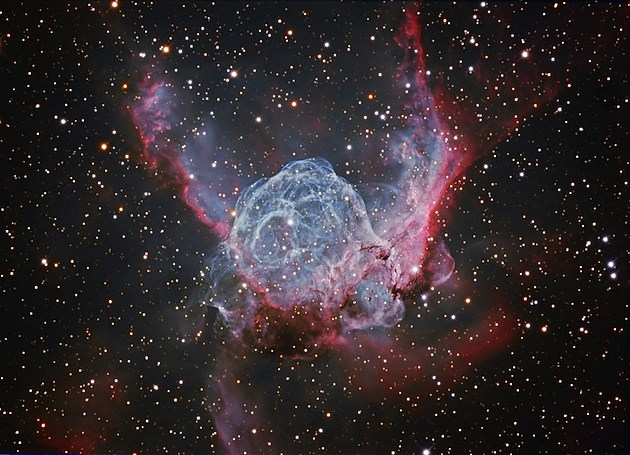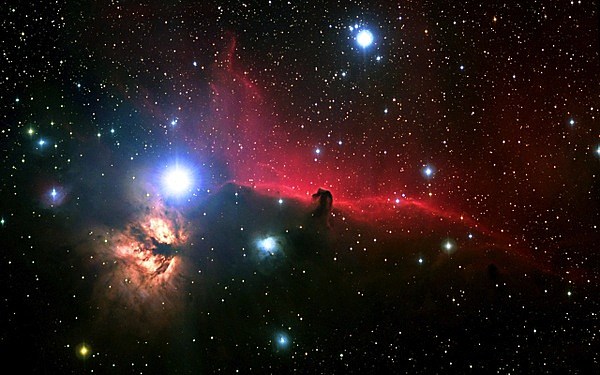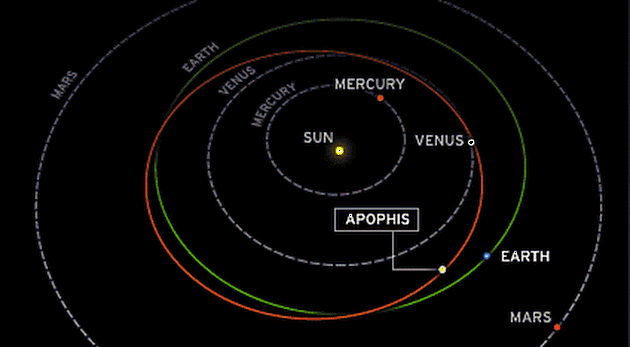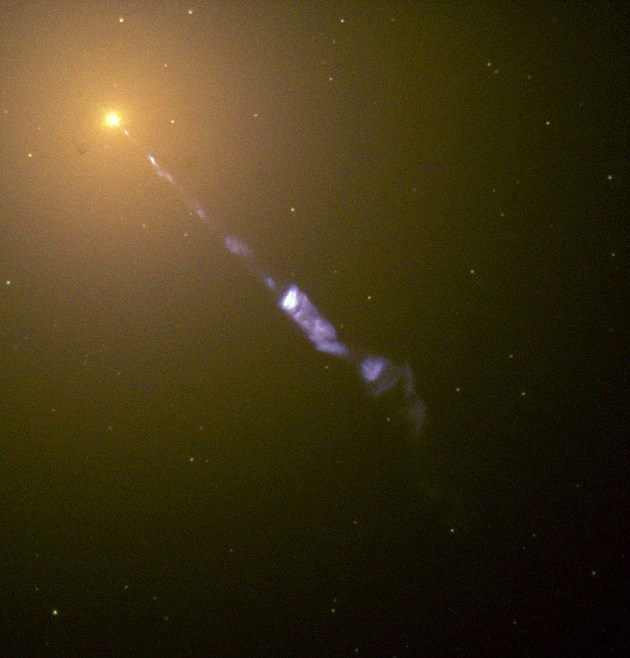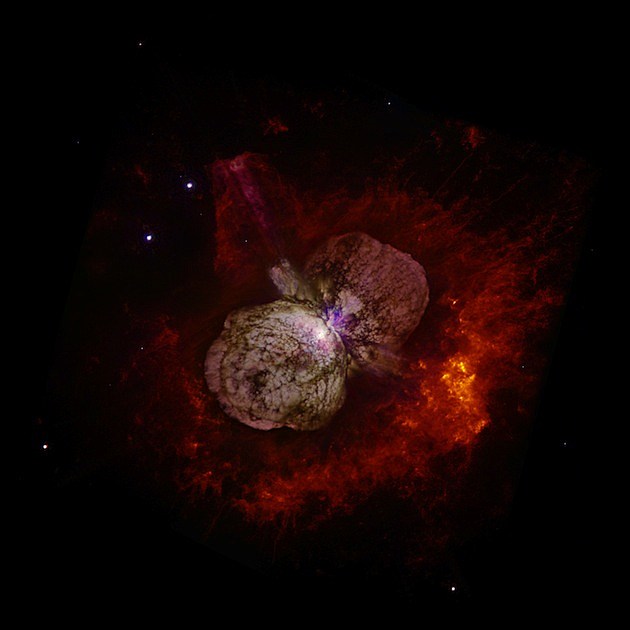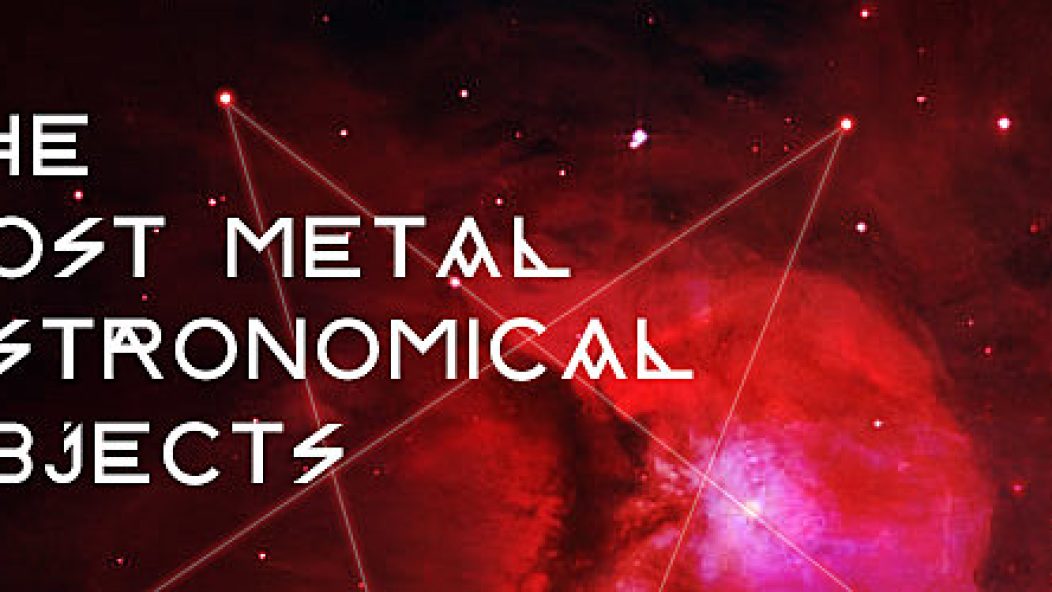
The Most Metal Astronomical Objects
. . .
Prologue
Much is made of metal’s fascination with and celebration of primeval nature. Nature in a most pristine form exists as the night sky, a night sky that everyone the world over can access. The sky is filled with beauty, and a range of entities, both strange and wondrous, inhabit the cosmos. Metal, as a celebration of nature, is one of few musical forms that have the ability to resonate with celestial wonders and astronomy as a pursuit. A number of objects in the universe both near and far push the boundaries of today’s knowledge and continue to have a hand in forever casting religion from the study of nature. These objects are perfectly suited to explore within the context of metal.
My own life experience demands that I connect with the cosmos on a regular basis, whenever I can. Naturally, a soundtrack is a part of these journeys, a soundtrack that is usually filled with releases of the stoner, doom, pagan/Viking, and black metal (muted) varieties. I find it rather strange that, in metal, many astronomically themed songs and motifs come from technical, or progressive, artists. To these ears, that approach rarely works, as the universe is here for us to contemplate, appreciate, and, ultimately, understand. In part, this is a reflective experience, an experience not enhanced by overbearing technical music.
Somewhat strangely, only a handful of bands within black, doom, drone, etc. flirt with astronomical themes, and usually then in only a minimal manner. For the most part, the minimalist approach is appreciated, but I am always seeking out more to fully flesh out the aural experience. I welcome your input.
The following list will count down the most metal astronomical objects and pair them with the appropriate soundtrack. Prepare to be humbled.
. . .
7. Algol
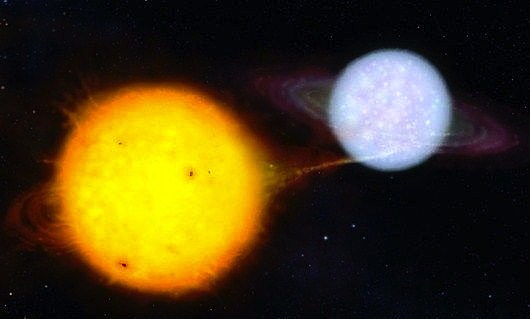
It’s not often that a single, seemingly ordinary looking star invokes dread in the superstitious minds of the ancients. The Winking Demon, Algol, is the second brightest star in the constellation of Perseus, and is easy to find in mid-autumn from the Northern Hemisphere. Algol is noteworthy from its original name in Arabic (most stars with proper names are derived from Arabic) al Ghul, which roughly translates to “The Demon’s Head”. Algol is also known as the Demon Star, or the Winking Demon, due to its behavior, which was noticed by ancient astronomers. Over a period of 2.867 days, Algol brightens and dims twice, with the biggest dip occurring by 30 percent in just a couple of hours.
To the ancients, the stars were static and eternal. Any change in the sky was regarded with dread as an omen of ill portent; hence, the ascribing of malevolence to a star that appears to “wink” with a regular period. The regular period of brightening and dimming indicates that Algol is an example of an eclipsing binary star.
An eclipsing binary is actually two stars in orbit about their common center of mass in an orbital plane that coincides with our line of sight. The brighter of the two stars, Algol A, is a blue star 3.5 times more massive than the Sun that is currently fusing hydrogen in its core; therefore, Algol A is what’s known as a main sequence star. The primary’s companion, Algol B, is an aging, bloated orange star that is intrinsically dimmer, less massive, and with a greater radius than that of the primary.
The companion passes almost directly in front of the primary once per orbit along our line of sight, causing the apparent brightness, known as the apparent magnitude, of the Algol system to decrease. One half of an orbital period later, however, the companion passes behind the primary, resulting in another dip in brightness that is not nearly as pronounced. The Winking Demon, by demonstrating change in the sky, helped bring down the religious superstition of a static universe centered upon the Earth.
In contrast to the other objects that follow, the Winking Demon Algol seems downright sedate. A perennial favorite of mine during telescope observing sessions is Acid King.
. . .
Acid King – “Sunshine and Sorrow”
. . .
6. Thor’s Helmet
A towering sculpture of gas and dust arising within the interstellar medium in the direction of the constellation Canis Major, the emission nebula known as Thor’s Helmet (NGC, or New General Catalogue, 2359) is the responsibility of a true behemoth amongst the stellar population: a Wolf-Rayet star. An extreme type of star, a Wolf-Rayet star is a violent, distant cousin of our yellow dwarf Sun that bears little resemblance to the giver of life that we all take for granted.
A true monster, a Wolf-Rayet star typically weighs in at 20 solar masses and above. Such stars do not last very long, burning through their nuclear fire at an unprecedented rate. With a lifetime of typically less than a few million years, very few Wolf-Rayet stars exist within our galaxy at any one time. Wolf-Rayet stars have an influence on their immediate surroundings as the violence that rules their existence propagates outwards as a stellar wind. This violent wind slams into the surrounding interstellar medium, thereby exciting primeval hydrogen, oxygen, and whatever other elements that are present to emit light at specific wavelengths. The result in this case, Thor’s Helmet, is fleeting; the Wolf-Rayet star will soon end its life in a violent supernova of titanic proportions. The core of the star at the heart of such an explosion will collapse, almost surely, into a black hole.
Valhalla awaits.
. . .
http://www.youtube.com/watch?v=hICrXs6Va60
Moonsorrow – “Kaiku”
. . .
5. The Horsehead Nebula
A star formation region in the constellation of Orion, the Horsehead Nebula and the immediately surrounding area is one of the most photographed regions of the sky. The nebula also appears on no less than five album covers of the death and black metal genres.
The nebula’s ethereal beauty showcases a number of features associated with both emission and dark nebulae. The shimmering red curtain of nebulosity is from the light emitted by hydrogen atoms, while the actual horse head is a dark molecular cloud silhouetted in the foreground. The region’s star formation is exhibited nicely to the lower left of most images, in an area referred to as the Flame Nebula.
The Horsehead Nebula is rather easy to find, as the brightest star in most images of the region is Zeta Orionis (Alnitak), the easternmost star in Orion’s Belt. Unfortunately, due to its dimness and poor contrast, the Horsehead Nebula is a poor object to observe by eye through a telescope.
The Horsehead Nebula is majestic. Of all the album covers that depict the Horsehead, Requiem Tenebrae by Nehëmah is the most intriguing.
Nehëmah – “In The Mists Of Orion’s Sword”
[audio: MISTS_NEHEMAH.mp3]4. Apophis
The Earth lies in the midst of a cosmic shooting gallery. Occasionally, the Earth is hit dead on. Just ask the hapless dinosaurs 65 million years ago when an estimated 10-mile wide asteroid, on a very bad day at the end of the Cretaceous, slammed into what is now known today as the Yucatan Peninsula.
The Earth is still occasionally hit by a sizable object. The Ries formation in Bavaria was formed by an asteroid about 15 million years ago. Meteor Crater in Arizona dates back about 50,000 years. Most famously, what was it that exploded in the atmosphere above the Tunguska River in Siberia in June of 1908? A cometary fragment seems most likely.
And then, there is 99942 Apophis. An example of a NEO, or Near Earth Object, Apophis is an asteroid that periodically cuts across the orbit of the Earth. A few hundred meters wide, Apophis was first noticed by vigilant asteroid hunters in late 2004. Subsequent observations of the asteroid’s orbital parameters gave Apophis as high as a 6% chance of hitting the Earth in 2029. The media, of course, went wild, even as follow up observations lowered the chance of Apophis striking the Earth in 2029 to effectively zero.
However, those observations showed that during Apophis’ close pass in 2029, a very slight chance existed for Apophis to pass through a gravitational “keyhole,” a condition necessary for the asteroid to strike the Earth on its next pass in 2036. Sadly, observations of Apophis’ orbital parameters in 2006 lowered the chance of an impact in 2036 to 1 in 250,000.
Apophis is a reminder of what lurks in the dark corners of the Solar System. If the object depicted on the cover of Massive Terrestrial Strike by Urgehal struck the Earth, the kinetic energy of such an impact would melt the entire Earth’s crust, thereby sterilizing the Earth.
. . .
http://www.youtube.com/watch?v=LQMG0tDX8XM
Urgehal – Massive Terrestrial Strike (Full)
3. Magnetar SGR 1806-20
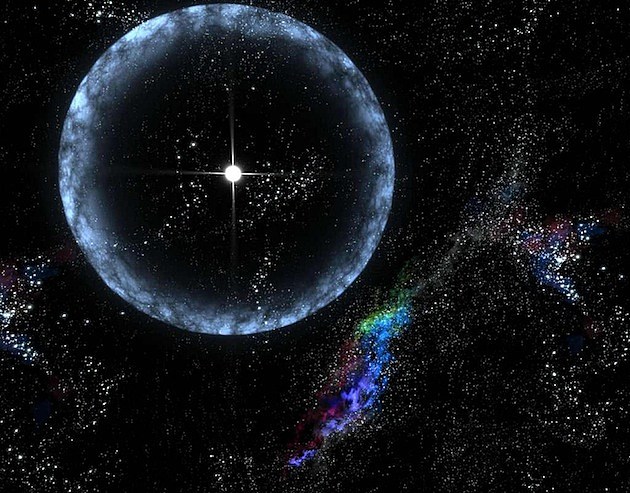
As if a neutron star, the leftover corpse of a massive star that ended its life in a supernova explosion wasn’t weird enough. On December 27th, 2004, satellites in orbit about the Earth detected a wash of gamma ray photons coursing through the Solar System. Lasting less than 1/10th of a second, the raging torrent of high energy radiation was eventually calculated to be more than the entire energy output of the Sun during the last 100,000 years. The explosion that caused the shower, whatever it was, was enough to affect the Earth’s upper atmosphere, briefly triggering an aurora flash witnessed by fishermen in the Arctic.
The culprit was soon traced to an exceptionally powerful beast of a neutron star called a magnetar. A magnetar is a recently formed neutron star that spins on its axis hundreds of times per second. Such millisecond pulsars, as most are called, are not that unusual, but magnetars have an extremely strong, tightly wrapped magnetic field. The magnetic field is so strong that it is capable of rupturing the densely packed neutrons that make up the magnetar’s solid crust. This rupturing is known as a starquake, and results in a release of energy almost unimaginable in scale.
This particular magnetar, SGR 1806-20 (the numbers refer to the object’s celestial coordinates in the sky), lies about 50,000 light years from Earth on the other side of the center of the Milky Way Galaxy in the direction of the constellation Sagittarius. The magnetar itself, several times the mass of the Sun, is only about 20 kilometers in diameter, about the size of a city. Yet this incredible object, on the other side of the galaxy no less, still packs a powerful enough punch to directly affect the Earth.
Essentially, magnetars are exotic millisecond pulsars, pulsars recently formed from the nuclear fire of supernova explosions. Should the beam of radiation given off by a pulsar sweep over the Earth, much like a lighthouse, that radiation can be heard as a series of radio pulses; hence, the name pulsar. Millisecond pulsars contain eerie harmonics, quite literally, as the following acoustical mix of such objects residing in the globular cluster 47 Tucanae, can attest.
Listen: Pulsar soundfile
Unsurprisingly, such frequencies have been incorporated into musical forms, but, equally surprising, not in metal, at least, to my knowledge. Sunn O))) and related artists would seem to be a logical choice for such harmonics, but I disagree. Millisecond pulsars represent incredible energies, the antithesis of drone; therefore, choose anything from Darkspace to personify the inhuman, frenetic rotation of Magnetar SGR 1806-20. I chose the following if for no other reason than the backdrop features the starburst galaxy M82 (an object for a Part II, perhaps?)
. . .
Darkspace – “3.17”
. . .
2. M87
At the center of every large galaxy including our own Milky Way lurks a Dragon. The Milky Way’s Dragon is a supermassive black hole weighing in at around 4 million solar masses. As big as this beast is, the Dragon of the Milky Way is relatively quiescent. Not so for a Dragon that lurks approximately 50 million light years away at the center of the galaxy M87.
M87 (or, Messier 87) is an impressive galaxy. Lying at the gravitational heart of the Virgo Supercluster of some 5,000 galaxies, of which the Milky Way is a distant member on the outskirts, the giant elliptical galaxy M87 contains several trillion stars and is probably, overall, at least 200 times as massive as our own Milky Way. If that’s not impressive enough, M87 harbors perhaps the single most massive object known in the local universe.
The supermassive black hole lying at the center of M87 weighs in at around 6 billion solar masses. The event horizon of such an object has a diameter greater than that of the Solar System. Adding fuel to the fire is an enormous jet of high energy radiation being blasted out of the core of the galaxy, where the black hole resides.
Discovered in the 1930s, the jet is now known to be the product of infalling material onto the black hole that is then blasted out at nearly the speed of light. The jet and its related material are nearly 250,000 light years long and are nearly pointed in our direction. A symmetric jet pointing in the opposite direction has also been observed.
How can it be that such that a huge amount of energy is blasted out of a black hole? Welcome to accretion disk physics. As material spirals down the drain, as it were, it flattens out into a disk, sort of similar to what happens with water in a bathtub. In M87’s case, the accretion disk is nearly half a light year wide with the gas at the edge of the disk moving at nearly 1,000 km/sec. That’s absolutely mind boggling.
A useful analogy regarding the infalling material into a supermassive black hole is that it’s like trying to fill a dog dish with a fire hose. As the accretion disk material orbits the black hole, material continuously falls towards the event horizon. As it does, that material is heated to enormous temperatures due to friction, resulting in a blast of X-rays and a jet of high energy particles and radiation directed along the poles of the disk. The jet is easily visible from our vantage point on Earth, nearly 50 million light years away.
What could possibly musically represent the sheer, mind boggling immensity that belies the reality of the Dragon of M87? Nothing. Metal is merely human art, an attempt to emulate the grandeur of nature.
. . .
Black Hole Generator – “The Age Of Anxiety”
. . .
1. Eta Carinae
The prospect of a star even more frightening than a Wolf-Rayet is unsettling to consider. Just so happens that such a star resides nearly on our cosmic doorstep. A mere 7,000 light years away at the heart of an enormous emission nebula in the southern constellation of Carina resides the star Eta Carinae. Eta Carinae was first noticed by European astronomers in the 19th century when the star inexplicably brightened to become the second brightest star in the sky. This behavior lasted for several decades before the star faded once again.
Intrigued, astronomers set out to study Eta Carinae in great detail after large telescopes were built in the Southern Hemisphere in the 20th century. Unfortunately, the picture that emerged was, at first, murky. As bright as the star is, it is apparently obscured by a rather large cloud of dust and gas. Only follow up observations with the Hubble Space Telescope began to reveal the true nature of the beast.
Eta Carinae is one of the few stars that we know of in our galaxy called a Luminous Blue Variable, or LBV. LBVs are extremely rare due to their extreme mass, and, hence, extremely short life spans. Eta Carinae, for example, could be upwards of 120 solar masses, and is, essentially, a titanic supernova waiting to happen. A strong possibility exists that Eta Carinae is actually two stars, with the primary being the LBV, and the secondary being a behemoth in its own right, weighing in at 30 solar masses. The two stars are an example of a binary system; that is, two stars in orbit about their common center of mass.
The supernova may be imminent. During the 19th century, the primary star very nearly exploded, shedding nearly 20 solar masses worth of material in a violent outburst, the outburst that was documented by astronomers of the day. The gas that is currently obscuring our direct view of the system, now called the Homunculus Nebula, is the result of that outburst. In a very famous HST photograph, each lobe of expanding gas is larger than the Solar System. The binary is obscured near the center of the lobes.
The primary star could explode at any time, an explosion that would rip apart the secondary star. When it does, the expanding supernova would be visible during the daytime for several weeks, if not months. The Earth, being 7,000 light years away, is just far enough from the star for the Earth’s atmosphere to shield the biosphere from any harmful effects. To put this in perspective, if a LBV exploded within 10 light years of the Earth (Eta Carinae is the closest LBV and there are only a handful in the galaxy, overall), the supernova’s ultra hard radiation would, most likely, sterilize the Earth.
The violence barely contained within Eta Carinae is palpable; therefore, death metal is a logical choice. Incidentally, I once asked Origin bassist Mike Flores why the Horsehead Nebula appears on the cover of the band’s first album (although he does not appear on the album). His reply was, “No reason. It just looks cool.”
. . .
Origin – “Saliga”
. . .
Afterword
Modern civilization is an impediment to a true appreciation of the night sky and the majesty therein. Of course, the same argument can be made for any aspect of the natural world, and we are all the worse off for that reason. I encourage you, dear reader, to seek out a place in which to contemplate the night sky. This may involve effort. You would have to remove yourself far from city lights, and, possibly, travel to a relatively remote area that is dry and, preferably, well above sea level. The experience will be a rich one for you, however, a richness in experience that I can not only attest to personally, but also to the hundreds of young people that I have exposed the majesty of the night sky to; that is, students of mine that I have had the honor and privilege of teaching over the last fifteen years.
I encourage you to go through the effort of obtaining access to a small telescope to fulfill that experience. The telescope is not only a most heretical instrument, an instrument that played no small role in casting religion from the study of the natural world forever, but a transformative one, as well. Your life may be forever changed by a glimpse of a nebula, a planet, or a galaxy, a glimpse all the more appreciated by knowing that the human species is capable of understanding the universe. Our civilization will be better off.
Dave Schalek teaches high school physics and astronomy in Southern California. His obsession may be metal, but his passion is teaching. He currently writes for Heavy Metal at About.com, and he has his own “little blog”, Metal Flows In My Veins.

